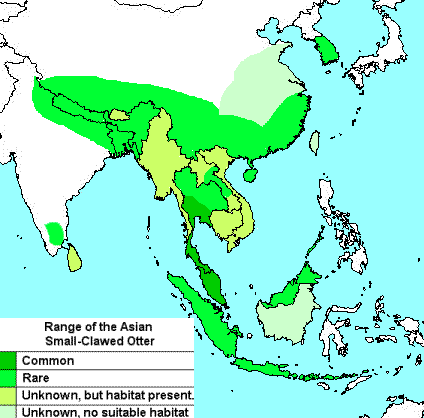Asian Small-Clawed Otter
Also known as the oriental small-clawed otter. They have deep brown fur with some rufous tinge on the back, but paler below. Its underfur is lighter near the base. The sides of their neck and head are brown, but its cheek, upper lip, chin, throat and sides of the neck is whitish. Its paws are a distinctive feature; its claws do not extend beyond the fleshy end pads of its partially webbed fingers and toes. They are the smallest species of otter in Asia.

Habitat
They are distributed from India to Southeast Asia including the islands of Sumatra, Java, Borneo and Palawan. In southern India, it occurs along shallow mountain creeks in hill ranges up to an elevation of 2,000m in Karnataka, Nilgiri and Palni hills in Tamil Nadu. Farther north, it occurs in coastal regions of Odisha, and in wetlands in West Bengal, Assam and Arunachal Pradesh. It inhabits freshwater wetlands such as swamps, meandering rivers, irrigated rice fields as well as estuaries, coastal lagoons and tidal pools. In western Java, it inhabits areas along slow-flowing irrigation channels, pond areas and rice fields surrounded by vegetation that offers shelter. It also occurs in mangroves.

Diet
They are carnivores and they mainly feed on crabs, mudskippers and Trichogaster fish. Its diet varies seasonally. When and where available, it also catches snakes, frogs, insects, rats and rice field fish like catfish, Anabas testudineus and Channa striata. The size of crabs found in spraints in Huai Kha Khaeng Wildlife Sanctuary ranged in carapace width from 10-44cm. Captive Asian small-clawed otters were observed to leave shellfish in the sun so that the heat causes them to open. That way, they consume the meat without having to crush the shells.
Breeding
They will form a monogamous pair for life. The alpha pair is the only one that breeds and the previous offspring help with raising the young. Breeding occurs throughout the year, two litters per year sometimes produced. After gestation of 60 days the litter of 1-6 (average 2) is born in their nesting burrow in the muddy riverbank. The males help make the nest burrow and bring food once the pups are born. Pups are relatively undeveloped when born, with eyes closed and weighing only two ounces . The first few weeks are spent nursing every 3-4 hours. They open their eyes at around 40 days and venture outside after about 10 weeks. Pups begin eating solid food at around 80 days, and weaning takes place at about 14 weeks. They can swim when about 3 months old. Young reach their adult size after about 6 months.
Population
No estimate of population size is available for Oriental small-clawed otters. According to the Woodland Park Zoo resource, the total population size of the species might be around 5,000 otters. Currently Oriental small-clawed otters are classified as Vulnerable (VU) on the IUCN Red List and their numbers today are decreasing.
Threats
The biggest threat today that they face is habitat destruction as people encroach into and drain wetland areas that these small mammals need to survive. Habitat fragmentation will eventually increase risk of inbreeding and the overall breeding success and genetic vigor. They have been hunted for their dense, velvety pelts, which like those of all otters, are dense with a velvety texture. Hunting is not, however, the main cause of the dwindling numbers.
Conservation
In 1981, a Species Survival Plan program was established for the Asian small-clawed otter, to be used as a model for other, more endangered social otter species. It was generally believed that otters would be difficult to breed reliably in human care, so work on appropriate husbandry procedures was begun on the small-clawed otters. Although not yet endangered, this is a valuable species to begin research on before breeding of other endangered otters was needed. By 1985 the first studbook was published and three years later a full master plan was developed. Intensive work has been done to learn more about the female reproductive cycle and the unique diseases to which this animal is susceptible.